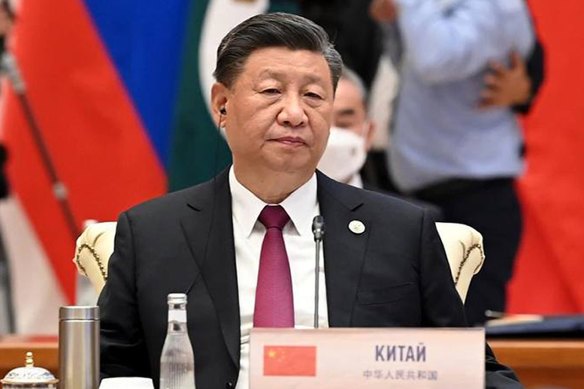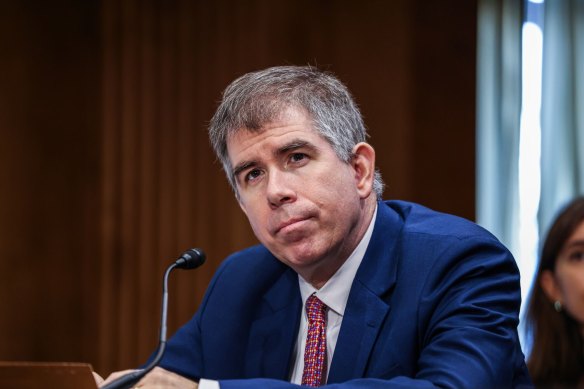Opinion
The US is losing patience with China
Stephen Bartholomeusz
Senior business columnistThe combination of China’s internal imbalances and Xi Jinping’s increasingly assertive geopolitical ambitions has led to increasing overcapacity in strategically sensitive industries and the exporting of goods and trade tensions around the world.
When China’s property sector imploded nearly three years ago, an implosion that overlapped a crackdown on the leaders of China’s then-booming technology sector, Beijing had nowhere to turn to sustain growth but manufactured exports.

The list of challenges facing Xi Jinping and China is growing.Credit: AP
Xi appears to have an aversion to any large-scale effort to stimulate domestic confidence and consumption, which have been undermined by the collapse in the property sector, apparently seeing government spending to lift consumption as wasteful. China’s demand for infrastructure investment had already been satiated.
So, Beijing’s industry strategies switched focus to boosting manufacturing investment, particularly in strategic sectors like solar, electric vehicles, and semiconductors, where China seeks global dominance.
The result has been significant levels of manufacturing industry overcapacity.
The average level of capacity utilisation in OECD economies is about 80 per cent. In China, the overall level in the first quarter of this year was 73.8 per cent but in solar it was 23 per cent, batteries less than 50 per cent and electric vehicles 65 per cent.
The utilisation rate for EVs was boosted by the success of companies like BYD, whose plants are operating at rates above 80 per cent, with the average utilisation rate in the sector below 50 per cent. As recently as 2017, the utilisation rate for China’s EV plants was almost 85 per cent.
The response to that excess capacity hasn’t been what would be expected in Western economies, where there would be plant closures, job losses, company failures, and industry consolidation.
Instead, China is trying to export that problem, with the volume of its exports rising 11.5 per cent in the March quarter but the value of those exports increasing only 1.5 per cent. The volume of exports of EVs was up 20 per cent in the quarter with exports of solar batteries increasing 30 per cent and semiconductors 25 per cent.
How should overcapacity be defined and why, given that most economies have some form of industry policy and some level of subsidies for strategic industries, should China’s be such a concern that it has ignited an expanding protectionist backlash from Beijing’s trading partners.
A senior US Treasury and trade official, Jay Shambaugh, gave a speech on Wednesday in which he said overcapacity is “not just production in excess of demand, but it is production capacity untethered from global demand”.
It isn’t just the existence of overcapacity, which is a feature of many sectors in other economies, but the extent of that overcapacity, the response to it, how it is deployed and when it is deployed via exports, the impact it has on international competitors and their own industries and, of course, the extent to which governments and their state-directed institutions have subsidised unproductive activity.
Dumping – exporting at sub-economic or loss-making prices that cost growth and jobs in other economies – isn’t an acceptable form of competitive advantage. It’s even less acceptable if it is done deliberately and heavily subsidised as part of long-term geo-economic and geopolitical strategies, which China’s stated strategic goals suggest might be the case with some of its exports today.
China’s share of global manufacturing is already 30 per cent of GDP, Shambaugh said. Its surplus as a share of global GDP is larger, he said, than the combined share of Japan and Germany at their peaks.
“Chinese policymakers’ clear preference today is to push manufacturing even further as China’s growth driver, which means taking on an increasingly outsized share of global production, with other countries’ manufacturing sectors needing to shrink to compensate,” he said.
“When Chinese production is growing faster than its own demand or that of the global economy, the rest of the world cannot absorb China’s increase in manufacturing production without being forced to adjust.”
“These conditions would not appear in a normal market economy. What we are seeing is a fundamental distortion, driven by government policy.”
Shambaugh cited analysis that China spends about five per cent of its GDP on industrial subsidies, which he said was 10 times that of the US, Germany, Japan and Brazil – and the size of those subsidies was increasing. In semiconductors, steel and aluminium, China accounted for 80 to 90 per cent of the global subsidies provided to those industries, he said.

Senior Biden administration official Jay Shambaugh has sent China a warning. Credit: Bloomberg
Other studies have estimated that China’s government investment funds provided more than $US1 trillion ($1.5 trillion) in capital and guarantees to more than 28,000 largely private firms between 2000 and 2018. One fund, which targets semiconductors, was larger than the entire US CHIPS & Science Act.
He said China’s production of lithium-ion batteries was set to exceed projected global demand by two to three times compared to what was necessary to achieve a path to net zero by 2050. Its planned production of EVs in 2030 of more than 70 million vehicles compared with estimates of global EV sales of only 44 million vehicles in that year.
If those scenarios were to play out, global prices in those sectors would fall, and most, if not all, production outside China would be wiped out.
If the telltales for pernicious levels of overcapacity are rising export volumes, falling export values, falling utilisation rates, increasing losses and high levels of government financial support, China ticks all the boxes.
The total number of loss-making companies is at its highest level since the 1990s. In the auto sector, about 28 per cent of the firms are losing money. Uneconomic and sub-economic companies are being propped up by Beijing’s or local government subsidies and/or non-commercial financing from state-controlled institutions.
In the first decade and a half of this century, China added 800 million tonnes of capacity in its steel sector, prices crashed, and much of the industry in the US and elsewhere was wiped out.
In solar, a flood of cheap Chinese exports, aided by what Shambaugh claimed was $US18 billion of below-market funding, resulted in an 80 per cent fall in international prices that effectively destroyed the industries in the US and Europe.
Having been burned by the experiences of steel and solar, the US, Europe, and others are determined not to allow history to repeat. Hence, trade barriers are steadily being erected, and not just in the developed economies.
If China is increasingly shut out of the major international markets, with increased tariffs in the US (and worse to come if Donald Trump regains the US presidency), the European Union planning to impose trade sanctions of its own, and other economies in South America, Asia, and Europe also responding to protect their own industries, China will be forced to rethink its strategies.
The obvious response, and one that has been obvious for quite some time, would be to boost domestic consumption by injecting cash into households, investing in improving social services and the social safety net, giving private companies more freedom to operate, and withdrawing excessive subsidies.
If it doesn’t shift course, the US and others harmed by the swelling flood of China’s exports will continue to respond and do whatever it takes to protect their own industries and economies. Shambaugh warned that if the traditional toolkit of trade actions (which includes the tariffs that Donald Trump imposed and Joe Biden has retained and expanded) weren’t sufficient, “more creative approaches may be necessary”.
The Business Briefing newsletter delivers major stories, exclusive coverage and expert opinion. Sign up to get it every weekday morning.